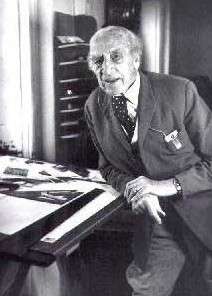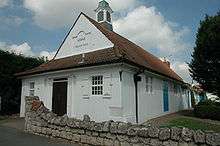Clough Williams-Ellis
| Sir Clough Williams-Ellis | |
|---|---|
 | |
| Born |
28 May 1883 Gayton, Northamptonshire, England |
| Died | 9 April 1978 (aged 94) |
| Occupation | Architect |
| Projects | Creator of the Italianate village of Portmeirion in North Wales |
Sir Bertram Clough Williams-Ellis, CBE, MC (28 May 1883 – 9 April 1978) was a British architect known chiefly as the creator of the Italianate village of Portmeirion in North Wales.
Life
Origins, education and early career

Clough Williams-Ellis was born in Gayton, Northamptonshire, England, but his family moved back to his father's native North Wales when he was four. The family have strong Welsh roots and Clough Williams-Ellis claimed direct descent from Owain Gwynedd, Prince of North Wales.[1]His father John Clough Williams Ellis (1833-1913) was a clergyman and noted mountaineer while his mother Ellen Mabel Greaves (1851-1941) was the daughter of the slate mine proprietor John Whitehead Greaves and sister of John Ernest Greaves.[2]
He was educated at Oundle School in Northamptonshire. Though he read for the natural sciences tripos at Trinity College, Cambridge, he never graduated. After a few months at the Architectural Association School of Architecture in London in 1903–04 (which he located by looking up "Architecture" in the London telephone directory), he worked for an architect for a few months before setting up his own practice in London. His first commission was probably Larkbeare, a summer house for Anne Wynne Thackeray and Mary Venables in Cumnor, Oxfordshire, in 1903-4 (finished 1907) which he designed whilst still a student.
Plas Brondanw, Pisé and Portmeirion

In 1908 he inherited a small country house, Plas Brondanw, from his father, restoring and embellishing it over the rest of his life, and rebuilding it after a fire in 1951. He served with distinction in the First World War, serving first with the Royal Fusiliers and then the Welsh Guards, with whom he was awarded the Military Cross. Postwar he helped John St Loe Strachey (who became his father in law) revive pisé construction in Britain, building an apple storehouse followed by Harrowhill Copse bungalow at Newlands Corner (photos) using shuttering and rammed earth. During the 1920s, he began work on Portmeirion, later the location for The Prisoner (1967–68) TV series.
Later life
.jpg)
A fashionable architect in the inter-war years, Williams-Ellis's other works include buildings at Stowe in Buckinghamshire; groups of cottages at Cornwell, Oxfordshire; Tattenhall in Cheshire; and Cushendun, County Antrim, Northern Ireland. Williams-Ellis is also known for his design (in the 1930s) of the former summit building on Snowdon, which - after unsympathetic alteration in the 1960s and a long-term lack of maintenance - was described by Prince Charles as "the highest slum in Wales".
It was during this period that Williams-Ellis wrote his book England and the Octopus (published in 1928); its outcry at the urbanization of the countryside and loss of village cohesion inspired a group of young women to form Ferguson's Gang. They took up Williams-Ellis's call for action and from 1927 to 1946 were active in rescuing important, but lesser known rural properties from being demolished: Shalford Mill in Surrey, Newtown Old Town Hall on the Isle of Wight and Priory Cottages in Oxfordshire were all successfully saved due to the Gang's fundraising efforts. The Gang endowed these properties and significant tracts of the Cornish Coastline to the care of the National Trust. The Gang’s mastermind Peggy Pollard (known within the Gang by her pseudonym Bill Stickers) and Williams-Ellis became lifelong friends.[3]
In 1929 Williams-Ellis bought portrait painter George Romney's house in Hampstead.[4]
Williams-Ellis also served on several government committees concerned with design and conservation and was instrumental in setting up the British National Parks after 1945. He wrote and broadcast extensively on architecture, design and the preservation of the rural landscape.
Family
In 1915 Williams-Ellis married the writer Amabel Strachey. Their son, Christopher Moelwyn Strachey Williams-Ellis (1923-13 March 1944), a Lieutenant in the Welsh Guards, was killed in action in Italy during the Second World War and was subsequently buried in plot VIII, row C, grave 24 at Minturno War Cemetery.[5] Their elder daughter, Susan Williams-Ellis, used the name Portmeirion Pottery for the company she created with her husband in 1961. Clough Williams-Ellis's great-nephew David Williams-Ellis is a renowned contemporary figurative sculptor.
Welsh language novelist Robin Llywelyn is his grandson.
Fashion designer Rose Fulbright-Vickers is his great-granddaughter.[6]
Honours
In 1958 Williams-Ellis was made a Commander of the Order of the British Empire "for public services".[7] He was made a Knight Bachelor in the New Year Honours 1972 "for services to the preservation of the environment and to architecture".[8] At the time, he was the oldest person ever to be knighted.[9]
Death
Sir Clough Williams-Ellis died in April 1978, aged 94. In accordance with his wishes, he was cremated, and his ashes went to make up a marine rocket, which was part of a New Year’s Eve firework display over the estuary at Portmeirion some twenty years after his death.
Works
Architecture
Writings
- Reconography (by student in BEF, pseudodonym Graphite) Pelman (1919 and 4 editions)
- England and the Octopus, London, Geoffrey Bles (1928)
- Cottage Building in Cob, Pise, Chalk and Clay: a Renaissance (1919)
- The Architect, London, Geoffrey Bles (1929)
- Cautionary Guide to Oxford, Design and Industrial Association (1930), 32 pages
- Cautionary Guide to St Albans, Design and Industrial Association (1930) 32 pages
- Laurence Weaver – a Biography, London, Geoffrey Bles (1933)
- Architecture Here and Now, London, T Nelson and Sons (1934)
- The Adventure of Building: being something about architecture and planning for intelligent young citizens and their backward elders, London, Architectural Press (1946), 91 pages
- An Artist in North Wales, London, Elek (1946), pictures by Fred Uhlman, 40 pages
- On Trust for the Nation (2 vols), London, Elek (1947), pictures by Barbara Jones, 168 pages
- Living in New Towns, London (1947)
- Town and Country Planning, Longmans, Green, London and British Council (1951), 48 pages
- Portmeirion, The Place and its Meaning, London (1963, revised edition 1973)
- Roads in the Landscape, Ministry of Transport (1967), 22 pages
- Architect Errant: The Autobiography of Clough Williams Ellis, London, Constable (1971), 251 pages
- Around the World in Ninety Years, Portmeirion (1978)
- With others
- Clough & Amabel Williams-Ellis, The Tank Corps (A War History), London (1919)
- ____ The Pleasures of Architecture London, Jonathan Cape (1924)
- ____ and Introduction by Richard Hughes, Headlong Down the Years, Liverpool University Press (1951), 118 pages
- Susan, Charlotte, Amabel and Clough Williams-Ellis, In and Out of Doors, London, Geo Routledge and Sons (1937) 491 pages
- With John Maynard Keynes, Britain and the Beast, London, Dent (1937), 332 pages
- With John Strachey, Architecture (1920, reprinted 2009), 125 pages
- With Sir John Summerson, Architecture Here and Now
References
- ↑ Clough Williams-Ellis family tree (Glasfryn) : Portmeirion - Welcome to the official Portmeirion village web site
- ↑ Dr Ioan Bowen Rees in Dictionary of Welsh Biography at http://yba.llgc.org.uk/en/s3-WILL-CLO-1833.html
- ↑ Polly Bagnall & Sally Beck (2015). Ferguson's Gang: The Remarkable Story of the National Trust Gangsters. Pavilion Books. ISBN 978-1-909-88171-6.
- ↑ "Romneys House". English Heritage list. English Heritage. Retrieved 9 December 2013.
- ↑ CWGC - Casualty Details
- ↑ http://www.telegraph.co.uk/luxury/womens-style/66873/rose-fulbright’s-deep-influences.html
- ↑ "Supplement to the London Gazette". London Gazette. 31 December 1957.
- ↑ "Supplement to the London Gazette". London Gazette. 31 December 1971.
- ↑ Chronology : Portmeirion - Welcome to the official Portmeirion village web site
External links
 Media related to Buildings by Clough Williams-Ellis at Wikimedia Commons
Media related to Buildings by Clough Williams-Ellis at Wikimedia Commons- North Antrim website with designs by Clough Williams-Ellis
- Official Portmeirion site
- Plas Brondanw
- Works by Clough Williams-Ellis at Project Gutenberg
- Works by or about Clough Williams-Ellis at Internet Archive